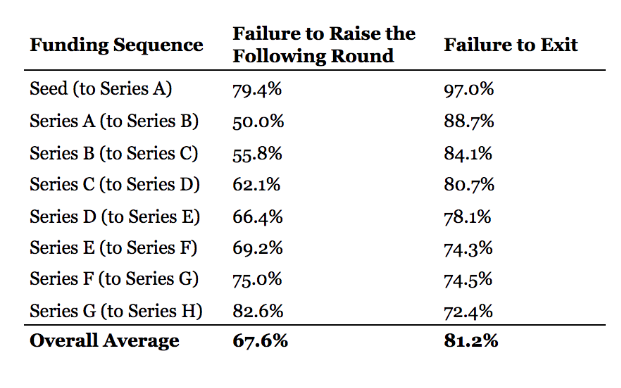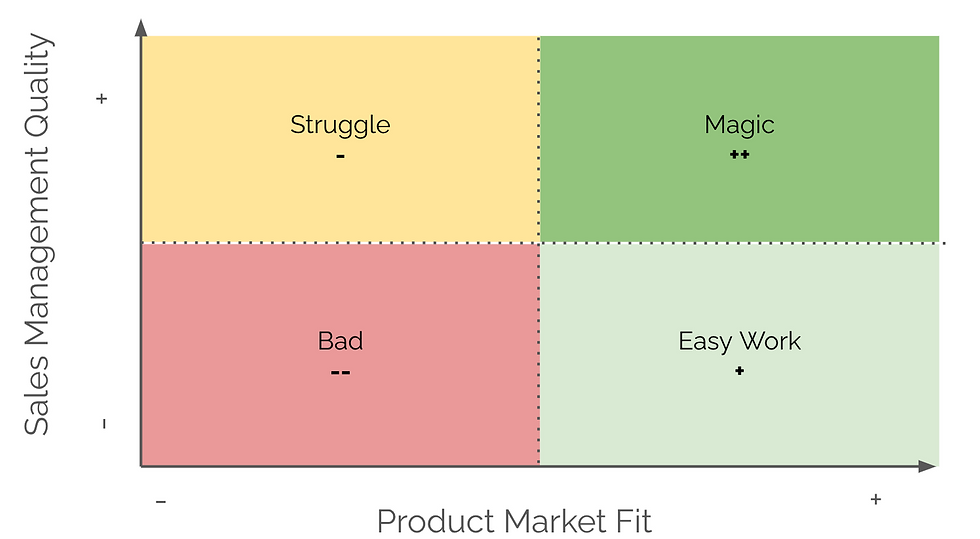The Limits of Sales Influence on Success
- Nils Brosch
- Sep 9
- 6 min read
I hesitated for a long time to write this article, as it sounds like an excuse and finger-pointing. I think most sales leaders would be scared to admit that product-market fit (PMF) (natural demand for your product) heavily determines your success as a sales leader - but that is the uncomfortable truth.
Embracing this truth could be a massive help to bend the odds of PMF in your favour, as sales leaders would start pushing for more influence on the product and executives would grant that influence more willingly.
I stumbled upon Product Market Fit
Looking back, I consider myself incredibly fortunate. Early in my career, I joined a company called Recruitee at a pivotal moment. The product had early signs of product-market fit, with significant inbound demand that I was able to leverage. While I had to implement best practices on the go and made several wise, unconventional decisions that led to an acceleration of growth, the truth is that I was lucky that I was selling a product that hit a nerve. I had stumbled upon strong Product-Market fit.
When I joined, Recruitee was generating just a few thousand euros in MRR. We grew fast by figuring out a system that worked—one grounded in a tight feedback loop between sales and product. By actively providing insights on what prospects and customers need, we were able to grow our MRR month over month in double digits for a long period.
I first needed to think about Product-Market Fit consciously, when growth started to slow and it was difficult to keep the double-digit month-over-month growth up. The company faced a critical decision: Should we attempt to create new inbound growth by experimenting with new niche ad platforms like Quora or Reddit? Or should we take a bold step, localize the product, and enter a completely new market? After much discussion with the CEO, we decided to double down on Germany—the largest market in Europe and one where we saw some inbound traffic despite having no localization.
As a German native, I led the charge. I handled deals myself, speaking directly with leads to gather feedback. Their responses were crystal clear: to compete in Germany, we needed integrations with the most prominent local job sites, functionality for Xing (the German equivalent of LinkedIn), and a few other market-specific features. We implemented these changes, and the impact was dramatic. Conversion rates in Germany skyrocketed.
This experience taught me a key lesson: product-market fit isn’t permanent, and you need to recalibrate PMF every time you change a variable (Product or Market) in the PMF equation.
To be precise, when we first reached €1 million ARR, I believed we had achieved product-market fit. But entering Germany showed us that PM fit isn’t a one-size-fits-all concept. Changing the market variable meant re-establishing alignment—adjusting the product and our sales strategy to meet the specific needs of a new audience.
After leaving Recruitee, I did consulting for over 50 B2B SaaS companies in early or growth stages, to help them define their go-to-market strategies. In all my time consulting, however, I’ve only seen product-market fit like what we achieved at Recruitee in two, maybe three, other companies.
This highlights an uncomfortable truth: no matter how skilled or experienced a sales leader or consultant is, there’s only so much they can achieve without a solid foundation of product-market fit.
Those of us sales leaders who have had a couple of success stories, often make the mistake of confusing luck (having PMF) with genius.
Product market fit at various company stages
Product Market Fit is the weight around your ankles, when you want to accelerate growth and EVERY sales leader is exposed to it. However, we often act as if we just need to ‘shut up and dribble’ as sales leaders.
Product Market Fit recalibration affecting sales leader success happens in most stages of a company to varying degrees - here are a few examples:
When entering a new geographical market
When moving up-market or down-market (i.e. PLG)
When adding a new product to the value proposition (not a feature, but a product)
When the competitive landscape has changed (i.e. competitor implemented AI, which changes market demands, or competitors are low-balling in pricing)

To expand on this: significant changes in either the product or the market require proactive effort to recalibrate PMF. For example, when you launch a new product or expand into becoming a multi-product company—something that often happens beyond €10 million ARR—you essentially reset the product-market fit equation and need to work actively to achieve alignment again. Similarly, changes to the market variable demand the same attention. Expanding into new geographies, targeting different segments, or moving upmarket all require deliberate adjustments to both product and sales strategy.
Writing about this topic makes me realize that this correlates with the death rate of startups, which seems logical as startups should only receive new funding once they’ve shown they were able to reach the next level of product market fit.

This recalibration is not limited to early-stage startups. While product-market fit challenges are most visible between €0–1 million ARR and €1–10 million ARR, they continue to surface even in mature scale-ups. Products can lose product-market fit over time due to competitive dynamics, evolving customer needs, or internal missteps in product decisions.
This also applies to mature companies a study shows that for S&P 500 companies, the average unique selling point or differentiator diminishes in about 1.5 years. This constant erosion means even large companies must actively maintain alignment.
Nevertheless, mature companies are mature for a reason, they probably have sections of their company that have strong PMF and others where the PMF is doubtful. So PMF calibration is less a company-wide effort but might be left to specific teams or country teams. So as the image below attempts to show, a mature company has a much wider footing to rely on (more green status PMF) than a startup company. Hence PMF is more of a discussion point for start / scale-ups. This is also why I advocate for thinking about product market fit as product market-segment fit instead.

In mature companies, maintaining product-market fit then often becomes primarily a product department-driven activity, reliant on structured processes to incorporate customer insights into continuous improvement cycles. Nevertheless, sales is still dependent on it going well to be successful.
Ultimately, whether in a startup or a scale-up, companies must recognize that product-market fit isn’t permanent. It is a fragile balance, easily disrupted by changes to the product, market, or competitive landscape. The key is for product and go-to-market teams to collaborate closely, keeping customer feedback at the centre of every decision.
Accepting this fundamental struggle underlying PMF in the evolution of any company implies that there is no silver bullet solution to this problem otherwise every startup would find PMF and become a unicorn (wishful thinking) and speaking about sales success without mentioning the degree of Product Market Fit is useless. Sales influencers must realise that JUST SELL à la Grant Cardone is simply idiotic.
What can we do
Is there a solution?
There is at least a better way to go about handling changes in PMF. Which entails:
Collaboration between product & sales until PMF is found in a new market/segment etc.
Executive buy-in and understanding of the particularities of the PMF phase even in more mature companies
As a reference, I can recommend listening to the podcast of a16z with the CEO of AppDynamics, Jyoti Basal (who exited for $3.7B to Cisco).
Collaboration between Product & Sales
PMF SWAT teams
Basal (CEO of AppDynamics) advocates the creation of a SWAT team of product & sales roles to tackle finding product market fit in a new market/segment. He also makes the difference between founding sales profiles that are suitable for opening markets and creating playbooks and sales profiles that know how to execute a playbook. The latter should only be hired once PMF has been established. Hence, keeping the ‘founder mode - sales team’ DNA at arm's length is paramount as it will be needed periodically whenever PMF recalibration is required.
Founder-Mode
For younger companies (<10M ARR) this simply means that the founder and or founding CCO must do the dirty work of opening a new market and channelling information back to the CPO directly.
Executive buy-in
Not understanding the tinkering process of finding PMF on the executive level would expose any project to likely failure. If management is unwilling to make resources available to adjust the product to the new market conditions, the journey for sales will be painful and the results will be very slow or non-existent.
A plea
Sales leaders are paid well but also have a tenure of less than 1.5 years. Blaming bad sales management for lack of results is easy, but fundamentally wrong.

Bad sales management on a strong PMF product will still yield better results than good management on a weak PMF product.
Sales leaders must claim more influence in the product development process and C-level must understand why and grant them access. It takes two to Tango 🙂
Here’s how I implement this realisation in how I help startups achieve Go-to-Market Fit:
1. I take a long-term approach with every client (no more monthly projects).
2. Process/strategy alone isn’t enough—it needs real-world testing. I sell myself, gather market feedback, and refine playbooks for the team.
3. If PMF is weak, I pause major GTM efforts until the product side is fixed (with my guidance).






Comments